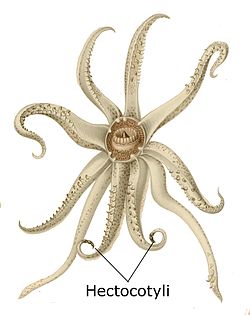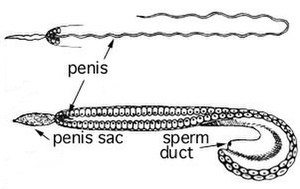
A hectocotylus (pl.: hectocotyli) is one of the arms of male cephalopods that is specialized to store and transfer spermatophores to the female. [1] Structurally, hectocotyli are muscular hydrostats. Depending on the species, the male may use it merely as a conduit to the female, analogously to a penis in other animals, or he may wrench it off and present it to the female.
Contents
The hectocotyl arm was first described in Aristotle's biological works. Although Aristotle knew of its use in mating, he was doubtful that a tentacle could deliver sperm. The name hectocotylus was devised by Georges Cuvier, who first found one embedded in the mantle of a female argonaut. Thinking it to be a parasitic worm, in 1829 Cuvier gave it a generic name (Hectocotyle), [2] [3] [4] [5] which is a New Latin term combining the Greek words for "hundred" (hec(a)to(n)) and for "hollow thing, cup" ( cotyle ).













